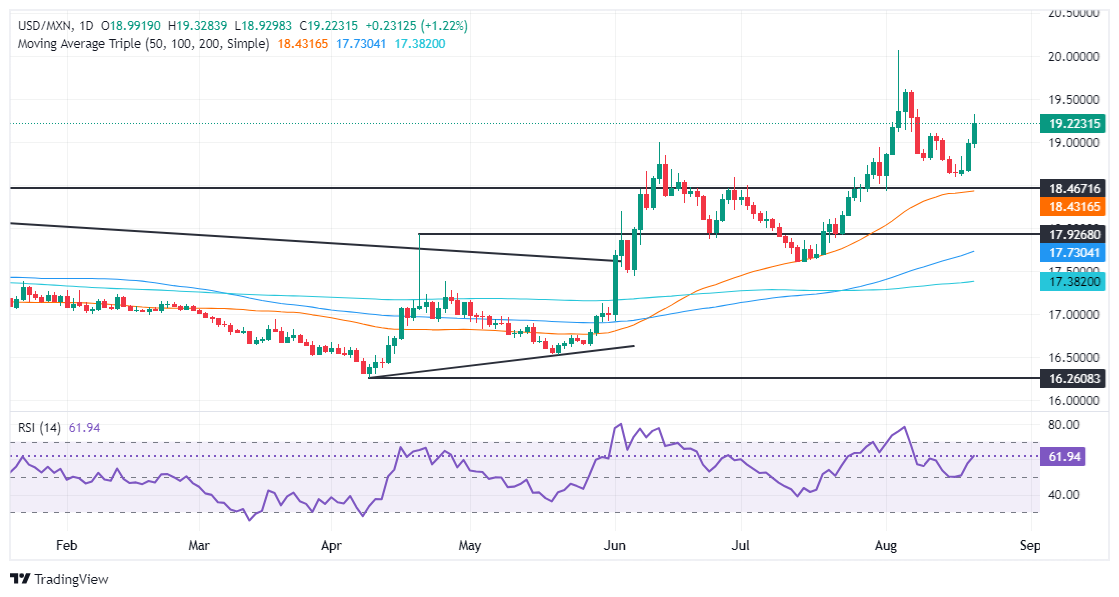Most recent article: Mexican Peso extends decline after release of UK and Eurozone PMI data
- Mexican Peso weakens after INEGI reports sharp declines in June Retail Sales with inflation concerns looming.
- US Dollar strengthens following downward revision of Nonfarm Payrolls by 800K.
- Fitch warns of rising debt risks for Mexico’s next administration with potential impacts on sovereign rating amid judicial reform controversy.
The Mexican Peso depreciated over 1.70% against the US Dollar in early trading on Wednesday as traders digested Mexico’s dismal Retail Sales report and awaited the release of a revision of US employment figures. The USD/MXN trades at 19.30 after bouncing off a daily low of 18.92.
Wall Street traded in the green, portraying optimism among investors. The Greenback advanced as the Bureau of Labor Statistics (BLS) revised the Nonfarm Payrolls (NFP) figures downward by 800K.
Meanwhile, on Tuesday, the Instituto Nacional de Estadistica Geografia e Informatica (INEGI) revealed that Retail Sales in June plunged in monthly and annual figures. In addition to this data, August’s mid-month inflation data is expected to tick up in core figures, while the headline is foreseen edging lower.
In the meantime, Fitch’s rating said that Mexico’s upcoming administration will face a growing debt above 51% of the Gross Domestic Product (GDP), which could affect the country’s sovereign rating.
The agency noted, “The fiscal strategy and governance reforms of the Sheinbaum government will be key factors for Mexico's rating.”
Fitch analysts added that judiciary reform “would negatively affect Mexico’s overall institutional profile, but the severity of their impact could become clearer once approved and implemented.”
Meanwhile, unions representing Mexico’s judicial workers launched an indefinite nationwide strike last Monday against President Andres Manuel Lopez Obrador's proposed judiciary reform.
According to Reuters, “The unions criticized the reform push in a statement as rushed and a danger to the "only counterweight" to the ruling Morena party's dominance of both the presidency and Congress.”
Juana Fuentes, the national director of Mexico’s Association of Federal Judges and Magistrates, which organized the strike vote on Tuesday, said, “If this bill passes, we will be creating a regime of absolute power concentrated in one single person.”
In addition, USD/MXN traders will be eyeing the release of the latest Federal Reserve (Fed) monetary policy meeting minutes.
Daily digest market movers: Mexican Peso weakens as data hints at economic slowdown
- Mexico’s Retail Sales for June dived -3.9% YoY, below expectations for a contraction of -1.7%. Every month, sales plunged -0.5%, below estimates of a 0.2% increase.
- Mid-month inflation in August is expected to drop from 5.61% YoY to 5.31%, while core figures are estimated to rise from 4.02% to 4.06%.
- Meanwhile, Mexico’s economy is expected to grow by 2.2% YoY, according to the Gross Domestic Product (GDP) final figures for the second quarter, which is against preliminary readings of 1.65%.
- The USD/MXN is also driven by interest rate differentials between the two countries. Although the spread has narrowed as the Bank of Mexico (Banxico) lowered rates at the August meeting, traders estimate the Fed will cut rates by at least 98 basis points, according to the CBOT fed funds rate December 2024 futures contract.
Technical analysis: Mexican Peso extends losses as USD/MXN climbs above 19.20
The USD/MXN uptrend remains intact and might continue, but stir resistance lies ahead. Momentum favors buyers with the Relative Strength Index (RSI) remaining bullish.
If the exotic pair extends its gains, the first resistance it would face would be 19.50. A breach of the latter will expose the psychological 20.00 figure, ahead of the year-to-date (YTD) high of 20.22.
On the flip side, on USD/MXN, there is further weakness. Peso’s buyers could drive the pair beneath the psychological 19.00 figure. Once cleared, the next stop would be the latest cycle low of 18.59, hit on August 19.
Mexican Peso FAQs
The Mexican Peso (MXN) is the most traded currency among its Latin American peers. Its value is broadly determined by the performance of the Mexican economy, the country’s central bank’s policy, the amount of foreign investment in the country and even the levels of remittances sent by Mexicans who live abroad, particularly in the United States. Geopolitical trends can also move MXN: for example, the process of nearshoring – or the decision by some firms to relocate manufacturing capacity and supply chains closer to their home countries – is also seen as a catalyst for the Mexican currency as the country is considered a key manufacturing hub in the American continent. Another catalyst for MXN is Oil prices as Mexico is a key exporter of the commodity.
The main objective of Mexico’s central bank, also known as Banxico, is to maintain inflation at low and stable levels (at or close to its target of 3%, the midpoint in a tolerance band of between 2% and 4%). To this end, the bank sets an appropriate level of interest rates. When inflation is too high, Banxico will attempt to tame it by raising interest rates, making it more expensive for households and businesses to borrow money, thus cooling demand and the overall economy. Higher interest rates are generally positive for the Mexican Peso (MXN) as they lead to higher yields, making the country a more attractive place for investors. On the contrary, lower interest rates tend to weaken MXN.
Macroeconomic data releases are key to assess the state of the economy and can have an impact on the Mexican Peso (MXN) valuation. A strong Mexican economy, based on high economic growth, low unemployment and high confidence is good for MXN. Not only does it attract more foreign investment but it may encourage the Bank of Mexico (Banxico) to increase interest rates, particularly if this strength comes together with elevated inflation. However, if economic data is weak, MXN is likely to depreciate.
As an emerging-market currency, the Mexican Peso (MXN) tends to strive during risk-on periods, or when investors perceive that broader market risks are low and thus are eager to engage with investments that carry a higher risk. Conversely, MXN tends to weaken at times of market turbulence or economic uncertainty as investors tend to sell higher-risk assets and flee to the more-stable safe havens.
Information on these pages contains forward-looking statements that involve risks and uncertainties. Markets and instruments profiled on this page are for informational purposes only and should not in any way come across as a recommendation to buy or sell in these assets. You should do your own thorough research before making any investment decisions. FXStreet does not in any way guarantee that this information is free from mistakes, errors, or material misstatements. It also does not guarantee that this information is of a timely nature. Investing in Open Markets involves a great deal of risk, including the loss of all or a portion of your investment, as well as emotional distress. All risks, losses and costs associated with investing, including total loss of principal, are your responsibility. The views and opinions expressed in this article are those of the authors and do not necessarily reflect the official policy or position of FXStreet nor its advertisers. The author will not be held responsible for information that is found at the end of links posted on this page.
If not otherwise explicitly mentioned in the body of the article, at the time of writing, the author has no position in any stock mentioned in this article and no business relationship with any company mentioned. The author has not received compensation for writing this article, other than from FXStreet.
FXStreet and the author do not provide personalized recommendations. The author makes no representations as to the accuracy, completeness, or suitability of this information. FXStreet and the author will not be liable for any errors, omissions or any losses, injuries or damages arising from this information and its display or use. Errors and omissions excepted.
The author and FXStreet are not registered investment advisors and nothing in this article is intended to be investment advice.
Recommended content
Editors’ Picks

Gold sits at fresh record high above $3,300 as US Dollar wilts on trade woes
Gold price remains within a striking distance of new record highs above $3,300 on Wednesday. Persistent worries about the escalating US-China trade war and US recession fears revive brroad US Dollar downtrend, boosting the traditional safe-haven Gold ahead of Fed Powell's speech.

EUR/USD holds firm above 1.1350 amid renewed US Dollar weakness
EUR/USD is storngly bid above 1.1350 in European trading on Wednesday. The pair draws support from a fresh round of selling in the US Dollar amid persistent fears over US-China trade war and a lack of progress on EU-US trade talks. US consumer data and Powell speech are in focus.

GBP/USD hangs close to fresh 2025-high above 1.3250 after UK CPI data
GBP/USD holds its six-day winning streak and stays close to its highest level since October above 1.3250 in the European session on Wednesday. The data from the UK showed that the annual CPI inflation softened to 2.6% in March from 2.8% in February but had little impact on Pound Sterling.

BoC set to leave interest rate unchanged amid rising inflation and US trade war
All the attention is expected to be on the Bank of Canada this Wednesday as market experts widely anticipate the central bank to maintain its interest rate at 2.75%, halting seven consecutive interest rate cuts.

Future-proofing portfolios: A playbook for tariff and recession risks
It does seem like we will be talking tariffs for a while. And if tariffs stay — in some shape or form — even after negotiations, we’ll likely be talking about recession too. Higher input costs, persistent inflation, and tighter monetary policy are already weighing on global growth.

The Best brokers to trade EUR/USD
SPONSORED Discover the top brokers for trading EUR/USD in 2025. Our list features brokers with competitive spreads, fast execution, and powerful platforms. Whether you're a beginner or an expert, find the right partner to navigate the dynamic Forex market.




